Miele T 4839 Ci User Manual

Operating instructions
for condenser tumble dryer T 4839 Ci
To avoid the risk of accidents |
en - GB |
or damage to the appliance |
|
it is essential to read these |
|
instructions before it is installed |
|
and used for the first time. |
M.-Nr. 06 731 781 |
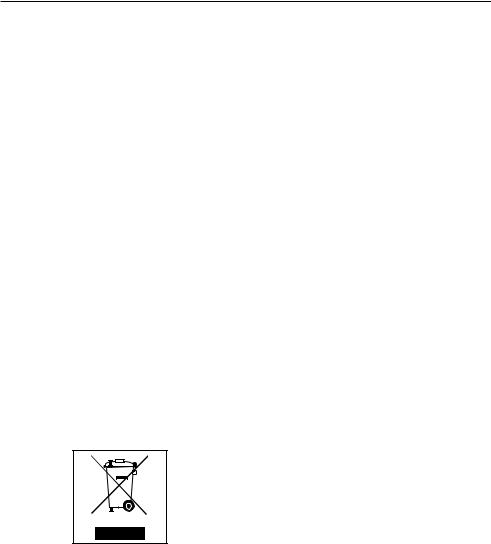
Caring for the environment
Disposal of the packing material
The transport and protective packing has been selected from materials which are environmentally friendly for disposal and can normally be recycled.
Ensure that any plastic wrappings, bags etc. are disposed of safely and kept out of the reach of babies and young children. Danger of suffocation!
Rather than just throwing these materials away, please ensure they are offered for recycling.
Disposal of your old appliance
Electrical and electronic appliances often contain materials which, if handled or disposed of incorrectly, could be potentially hazardous to human health and to the environment. They are, however, essential for the correct functioning of your appliance. Please do not therefore dispose of your appliance with your household waste.
Please dispose of it at your local community waste collection / recycling centre or contact your Dealer for advice. Ensure that it presents no danger to children while being stored for disposal.
Energy saving tips
To avoid unnecessarily long drying times and high consumption of energy:
–Make sure that your laundry is thoroughly spun before drying.
The higher the spin, the greater the savings that can be made in energy and time during drying.
–Load according to the optimum amount of laundry recommended for the programme being used (see Programme chart).
Underloading is uneconomical. Overloading gives a poorer quality of drying and may cause unnecessary creasing.
–Make sure the room in which the dryer is located is well ventilated.
–Make sure the fluff filters are clean before using the dryer.
–Check the condenser unit from time to time and clean it when necessary.
2

Contents
Caring for the environment . . . . . . . . . . . . . . . . . . . . . . . . . . . . . . . . . . . . . . . . . . 2
Warning and Safety instructions . . . . . . . . . . . . . . . . . . . . . . . . . . . . . . . . . . . . . 6
Operating the tumble dryer . . . . . . . . . . . . . . . . . . . . . . . . . . . . . . . . . . . . . . . . . 10
Control panel . . . . . . . . . . . . . . . . . . . . . . . . . . . . . . . . . . . . . . . . . . . . . . . . . . . . . 10 Display . . . . . . . . . . . . . . . . . . . . . . . . . . . . . . . . . . . . . . . . . . . . . . . . . . . . . . . . . . 11
Before using for the first time. . . . . . . . . . . . . . . . . . . . . . . . . . . . . . . . . . . . . . . 13
Notes on laundry care . . . . . . . . . . . . . . . . . . . . . . . . . . . . . . . . . . . . . . . . . . . . . 14
Care symbols . . . . . . . . . . . . . . . . . . . . . . . . . . . . . . . . . . . . . . . . . . . . . . . . . . . . . 14 Tips on drying . . . . . . . . . . . . . . . . . . . . . . . . . . . . . . . . . . . . . . . . . . . . . . . . . . . . 14
How to dry correctly . . . . . . . . . . . . . . . . . . . . . . . . . . . . . . . . . . . . . . . . . . . . . . 15
Brief instructions . . . . . . . . . . . . . . . . . . . . . . . . . . . . . . . . . . . . . . . . . . . . . . . . . . 15
Extra options . . . . . . . . . . . . . . . . . . . . . . . . . . . . . . . . . . . . . . . . . . . . . . . . . . . . 18
Low temperature . . . . . . . . . . . . . . . . . . . . . . . . . . . . . . . . . . . . . . . . . . . . . . . . . . 18 Short. . . . . . . . . . . . . . . . . . . . . . . . . . . . . . . . . . . . . . . . . . . . . . . . . . . . . . . . . . . . 18 Anti-crease . . . . . . . . . . . . . . . . . . . . . . . . . . . . . . . . . . . . . . . . . . . . . . . . . . . . . . . 18 Buzzer . . . . . . . . . . . . . . . . . . . . . . . . . . . . . . . . . . . . . . . . . . . . . . . . . . . . . . . . . . 18
Delay start. . . . . . . . . . . . . . . . . . . . . . . . . . . . . . . . . . . . . . . . . . . . . . . . . . . . . . . 19
Programme chart . . . . . . . . . . . . . . . . . . . . . . . . . . . . . . . . . . . . . . . . . . . . . . . . . 20
Changing the programme sequence . . . . . . . . . . . . . . . . . . . . . . . . . . . . . . . . . 25
Once a programme has started. . . . . . . . . . . . . . . . . . . . . . . . . . . . . . . . . . . . . . . 25 - changing the programme . . . . . . . . . . . . . . . . . . . . . . . . . . . . . . . . . . . . . . . . 25 - cancelling the programme and then selecting a different programme . . . . . 25 - cancelling the programme and then removing the laundry . . . . . . . . . . . . . . 25
Adding or removing laundry after a programme has started. . . . . . . . . . . . . . . . . 25 Time remaining . . . . . . . . . . . . . . . . . . . . . . . . . . . . . . . . . . . . . . . . . . . . . . . . . . . 25
3

Contents
Cleaning and care . . . . . . . . . . . . . . . . . . . . . . . . . . . . . . . . . . . . . . . . . . . . . . . . 26
Emptying the condensed water container . . . . . . . . . . . . . . . . . . . . . . . . . . . . . . . 26 Cleaning the fluff filters. . . . . . . . . . . . . . . . . . . . . . . . . . . . . . . . . . . . . . . . . . . . . . 27 Cleaning them whilst dry . . . . . . . . . . . . . . . . . . . . . . . . . . . . . . . . . . . . . . . . . 27 Cleaning them with water . . . . . . . . . . . . . . . . . . . . . . . . . . . . . . . . . . . . . . . . . 28 Cleaning the tumble dryer . . . . . . . . . . . . . . . . . . . . . . . . . . . . . . . . . . . . . . . . . . . 29 Cleaning the condenser unit . . . . . . . . . . . . . . . . . . . . . . . . . . . . . . . . . . . . . . . . . 30 Removing the condenser unit. . . . . . . . . . . . . . . . . . . . . . . . . . . . . . . . . . . . . . 30 Checking the condenser unit . . . . . . . . . . . . . . . . . . . . . . . . . . . . . . . . . . . . . . 31 Cleaning the condenser unit . . . . . . . . . . . . . . . . . . . . . . . . . . . . . . . . . . . . . . 31 Replacing the condenser unit. . . . . . . . . . . . . . . . . . . . . . . . . . . . . . . . . . . . . . 32
Problem solving guide . . . . . . . . . . . . . . . . . . . . . . . . . . . . . . . . . . . . . . . . . . . . 33
Fault messages in the display . . . . . . . . . . . . . . . . . . . . . . . . . . . . . . . . . . . . . . . . 33 Other problems . . . . . . . . . . . . . . . . . . . . . . . . . . . . . . . . . . . . . . . . . . . . . . . . . . . 35 Changing the lamp . . . . . . . . . . . . . . . . . . . . . . . . . . . . . . . . . . . . . . . . . . . . . . . . 38
After Sales service. . . . . . . . . . . . . . . . . . . . . . . . . . . . . . . . . . . . . . . . . . . . . . . . 39
Future updates (PC). . . . . . . . . . . . . . . . . . . . . . . . . . . . . . . . . . . . . . . . . . . . . . . . 39 Appliance guarantee . . . . . . . . . . . . . . . . . . . . . . . . . . . . . . . . . . . . . . . . . . . . . . . 39 Optional accessories . . . . . . . . . . . . . . . . . . . . . . . . . . . . . . . . . . . . . . . . . . . . . . . 39
Installation . . . . . . . . . . . . . . . . . . . . . . . . . . . . . . . . . . . . . . . . . . . . . . . . . . . . . . 40
Front view . . . . . . . . . . . . . . . . . . . . . . . . . . . . . . . . . . . . . . . . . . . . . . . . . . . . . . . . 40 Installation site . . . . . . . . . . . . . . . . . . . . . . . . . . . . . . . . . . . . . . . . . . . . . . . . . . . . 41 Building under a continous worktop / in a kitchen run . . . . . . . . . . . . . . . . . . . 41 Aligning the appliance . . . . . . . . . . . . . . . . . . . . . . . . . . . . . . . . . . . . . . . . . . . 42 Room in which the dryer is located. . . . . . . . . . . . . . . . . . . . . . . . . . . . . . . . . . 42 Washer-dryer stack . . . . . . . . . . . . . . . . . . . . . . . . . . . . . . . . . . . . . . . . . . . . . . 42 Before moving the tumble dryer again (e.g. when moving house) . . . . . . . . . . 42 Matching the fascia panel to the height of adjacent drawer fronts . . . . . . . . . . . . 43 Removing the spacer bars . . . . . . . . . . . . . . . . . . . . . . . . . . . . . . . . . . . . . . . . 43 Fitting the front panel . . . . . . . . . . . . . . . . . . . . . . . . . . . . . . . . . . . . . . . . . . . . . . . 44 Front panel dimensions. . . . . . . . . . . . . . . . . . . . . . . . . . . . . . . . . . . . . . . . . . . 44 Fitting the front panel . . . . . . . . . . . . . . . . . . . . . . . . . . . . . . . . . . . . . . . . . . . . 44
4

Contents
Fitting a door front panel made by another manufacturer . . . . . . . . . . . . . . . . . . . 45 Preparing the front panel . . . . . . . . . . . . . . . . . . . . . . . . . . . . . . . . . . . . . . . . . 45 Preparing the fixing points . . . . . . . . . . . . . . . . . . . . . . . . . . . . . . . . . . . . . . . . 46 Fitting a plinth facing . . . . . . . . . . . . . . . . . . . . . . . . . . . . . . . . . . . . . . . . . . . . . . . 47 External condensed water outlet . . . . . . . . . . . . . . . . . . . . . . . . . . . . . . . . . . . . . . 48 Arranging the drain hose . . . . . . . . . . . . . . . . . . . . . . . . . . . . . . . . . . . . . . . . . 48 External drainage via a sink or gully . . . . . . . . . . . . . . . . . . . . . . . . . . . . . . . . 49 Installation conditions requiring a non-return valve . . . . . . . . . . . . . . . . . . . . . 49
Electrical connection . . . . . . . . . . . . . . . . . . . . . . . . . . . . . . . . . . . . . . . . . . . . . 51
Electrical connection U.K. . . . . . . . . . . . . . . . . . . . . . . . . . . . . . . . . . . . . . . . . . . . 51
Consumption data . . . . . . . . . . . . . . . . . . . . . . . . . . . . . . . . . . . . . . . . . . . . . . . . 52
Technical data . . . . . . . . . . . . . . . . . . . . . . . . . . . . . . . . . . . . . . . . . . . . . . . . . . . 53
Settings menu J . . . . . . . . . . . . . . . . . . . . . . . . . . . . . . . . . . . . . . . . . . . . . . . . . . 55
To open the Settings menu . . . . . . . . . . . . . . . . . . . . . . . . . . . . . . . . . . . . . . . . . . 55 To close the Settings menu . . . . . . . . . . . . . . . . . . . . . . . . . . . . . . . . . . . . . . . . . . 55 Language J . . . . . . . . . . . . . . . . . . . . . . . . . . . . . . . . . . . . . . . . . . . . . . . . . . . . . . 55 Time (of day) . . . . . . . . . . . . . . . . . . . . . . . . . . . . . . . . . . . . . . . . . . . . . . . . . . . . . 56 Drying levels . . . . . . . . . . . . . . . . . . . . . . . . . . . . . . . . . . . . . . . . . . . . . . . . . . . . . 56 Extended cool down . . . . . . . . . . . . . . . . . . . . . . . . . . . . . . . . . . . . . . . . . . . . . . . 56 Airways indicator . . . . . . . . . . . . . . . . . . . . . . . . . . . . . . . . . . . . . . . . . . . . . . . . . . 57 Lock code . . . . . . . . . . . . . . . . . . . . . . . . . . . . . . . . . . . . . . . . . . . . . . . . . . . . . . . 57 Buzzer . . . . . . . . . . . . . . . . . . . . . . . . . . . . . . . . . . . . . . . . . . . . . . . . . . . . . . . . . . 59 Keypad tone. . . . . . . . . . . . . . . . . . . . . . . . . . . . . . . . . . . . . . . . . . . . . . . . . . . . . . 59 Contrast . . . . . . . . . . . . . . . . . . . . . . . . . . . . . . . . . . . . . . . . . . . . . . . . . . . . . . . . . 59 Brightness . . . . . . . . . . . . . . . . . . . . . . . . . . . . . . . . . . . . . . . . . . . . . . . . . . . . . . . 59 Standby display . . . . . . . . . . . . . . . . . . . . . . . . . . . . . . . . . . . . . . . . . . . . . . . . . . . 59 Memory . . . . . . . . . . . . . . . . . . . . . . . . . . . . . . . . . . . . . . . . . . . . . . . . . . . . . . . . . 59
5
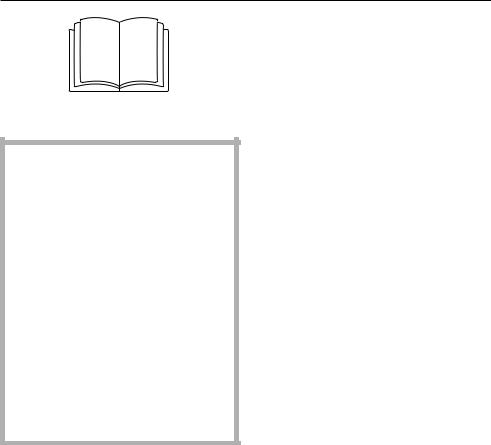
Warning and Safety instructions
~ It is essential to read these instructions.
This tumble dryer conforms to current safety requirements. Inappropriate use can, however, lead to personal injury and damage to property.
To avoid the risk of accidents and damage to the tumble dryer, please read these instructions carefully before using it for the first time. They contain important information on its safety, installation, use and maintenance.
Keep these instructions in a safe place and ensure that new users are familiar with the content. Pass them on to any future owner.
Correct application
~This tumble dryer is only intended for drying fabrics which have been washed in a water solution, and marked on the manufacturer's care label as being suitable for tumble drying.
"Dry cleaning kits" for freshening up garments in a tumble dryer are increasingly available on the market. If using, do so at your own risk, and follow the instructions provided on the packaging.
Any other applications may be dangerous. Miele cannot be held liable for damage resulting from incorrect or improper use or operation.
~This appliance is not intended for use by persons (including children) with reduced physical, sensory or mental capabilities, or lack of experience or knowledge, unless they are supervised whilst using it or have been shown how to use it by a person responsible for their safety.
Safety with children
~Keep children away from the tumble dryer at all times. It is not a toy! To avoid the risk of injury do not allow them to play on or near it or to play with its controls. Supervise children whilst you are using it.
~Older children may only use it if its operation has been clearly explained to them, and they are able to use it safely, recognising the dangers of incorrect use.
6

Warning and Safety instructions
Technical safety
~Before setting up the tumble dryer, check it for any externally visible damage.
Do not install or use a damaged tumble dryer.
~Before connecting the tumble dryer, ensure that the connection data on the data plate (voltage and connected load) match the mains electricity supply. If in any doubt, consult a qualified electrician.
~The electrical safety of this tumble dryer can only be guaranteed when continuity is complete between it and an effective earthing system which complies with current local and national safety regulations. It is most important that this basic safety requirement is present and regularly tested, and where there is any doubt the household wiring system should be inspected by a qualified electrician. Miele cannot be held liable for the consequences of an inadequate earthing system (e.g. electric shock).
~Do not connect the tumble dryer to the mains electricity supply by an extension lead. Extension leads do not guarantee the required safety of the tumble dryer (e.g. danger of overheating).
~Unauthorised repairs could result in unforeseen dangers for the user, for which Miele cannot accept liability. Repairs should only be undertaken by a Miele approved service technician. Ensure current is not supplied to the tumble dryer until after maintenance or repair work has been carried out.
~Faulty components must only be replaced by genuine Miele original spare parts. Only when these parts are fitted can the safety standards of the tumble dryer be guaranteed.
~If the connection cable is faulty it must only be replaced by a Miele approved service technician to protect the user from danger.
~In the event of a fault or for cleaning purposes, the tumble dryer is only completely isolated from the electricity supply when:
–it is switched off at the wall socket and the plug is withdrawn, or
–it is switched off at the mains, or
–the mains fuse is disconnected, or the screw-out fuse is removed (in countries where this is applicable).
~This tumble dryer may only be used in mobile installations such as ships if a risk assessment of the installation has been carried out by a suitably qualified engineer.
~In countries where there are areas which may be subject to infestation by cockroaches or other vermin, pay particular attention to keeping the tumble dryer and its surroundings in a clean condition at all times. Any damage which may be caused by cockroaches or other vermin will not be covered by the guarantee.
~Do not make any alterations to the tumble dryer, unless authorised to do so by Miele.
7

Warning and Safety instructions
Correct use
~ To prevent the risk of fire, the following textiles must not be dried in this tumble dryer:
–items which have not been washed.
–items, such as workwear, which have not been thoroughly cleaned and which are still soiled with grease, oil or other desposits (such as cosmetics, lotions etc).
If items have not been thoroughly cleaned there is a danger that these might ignite when heated, even after they have been removed from the dryer at the end of the programme.
–items which have been treated with inflamable cleaning agents or contain residues of acetone, alcohol, benzine, petrol, stain remover, turpentine, wax, wax remover or other chemicals (e.g. mops and floor cloths).
–items which have been splashed with hair lacquer, hair spray, nail varnish remover or similar substances.
When washing such heavily soiled items ensure that you use sufficient detergent and select a high temperature. If in doubt, wash the items several times.
~ To prevent the risk of fire, the following must not be dried in this tumble dryer:
–fabrics which contain a large proportion of rubber, foam rubber or rubber-like materials. For example, products made from latex foam rubber, shower caps, waterproof textiles, rubberised articles and items of clothing and pillows with foam rubber filling.
–items which contain padding or fillings (e.g. pillows, jackets). If these were damaged the filling could get out with the risk of igniting in the dryer.
~In many programmes, the heating phase is followed by a cooling down phase to ensure that the items are not too hot to handle when you remove them (this also avoids the danger of the laundry self-igniting). The programme is not finished until the cooling down phase is complete.
Ensure that you always wait until the end of the programme before removing the laundry.
~Warning: Do not switch the tumble dryer off before the end of the drying programme. If this was done and the laundry was then removed immediately, it could give off a great amount of heat.
~Fabric conditioner and similar products must be used according to the instructions on the manufacturer's packaging.
8

Warning and Safety instructions
~The dryer must not be used without the fluff filters in place or if the fluff filters are damaged in any way.
~The fluff filters must be cleaned regularly.
~The dryer must not be used without the condenser unit in place.
~The fluff filters must be thoroughly dried after cleaning. Damp or wet filters could cause operational faults.
~Do not install the tumble dryer in a room where there is a risk of frost occurring. At temperatures around freezing point the tumble dryer may not be able to operate properly.
There is a risk of damage if the condensed water is allowed to freeze in the pump, hoses and / or condensed water container.
The ambient room temperature should be between +2°C and +35°C.
~If the water is drained externally through the drain hose instead of being collected in the condensed water container, make sure the drain hose is securely attached if you hang it in a sink or basin to avoid the hose slipping and the water causing damage.
~Condensed water is not drinking water.
It can cause health problems in both people and animals.
~Always keep the area around the tumble dryer free of dust and fluff. Dust drawn into the tumble dryer can cause blockages in the condenser unit over time.
~Do not let anyone sit or lean on the door, as this can cause the tumble dryer to tip up.
~Always close the door after use. This way you will avoid the danger of:
–children climbing onto or into the dryer or hiding things in it.
–pets or other small animals climbing into it.
~ The tumble dryer must not be hosed down.
Accessories
~ Only use genuine Miele spare parts and accessories with this appliance.
If non-Miele parts are used, guarantee, performance and product liability claims may be invalidated.
Miele cannot be held liable for damage caused by non-compliance with these Warning and Safety instructions.
9
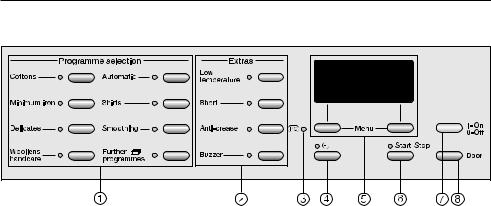
Operating the tumble dryer
Control panel
a Programme buttons
For selecting a drying programme.
b Extra option buttons
Various extra options can be added to the drying programmes.
c PC / Optical interface
This is used by service technicians to run diagnostic checks on your machine and can also be used to update programming data in the future.
d m button
For selecting delay start and calling up the time of day in the display.
e Display with Menu buttons
See the next page for more information.
f Start/Stop button
For starting the programme selected and cancelling a programme once it has started.
The indicator light flashes while a programme is being selected and then is on constantly when the programme has started.
gI-On/0-Off button
To switch the machine on or off or to interrupt a programme.
h Door button
Pressing this button will open the door even when the machine is switched off at the mains.
10

Operating the tumble dryer
Display
The display is used for the following:
Selecting and displaying settings
–Selecting different drying levels (e.g.
Hand iron, Normal ...)
or the duration of the Warm air and Cool air programmes
–Selecting delay start
–Displaying the drying duration (Estimated time remaining)
Note
All the display illustrations and times given in these instructions are examples, and can vary.
Selecting programmes via the display
By pressing the Further programmes button, you can select one of the following programmes:
–Denim
–Cool air
–Warm air
–Standard Pillows
–Large Pillows
–Silks handcare
–Sportswear
–Outerwear
–Proofing
–Cottons hygiene
–Minimum iron hygiene
–Timed drying hygiene
11
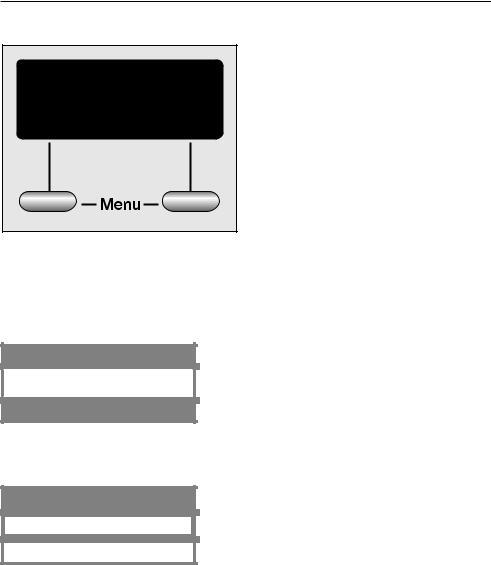
Operating the tumble dryer
Menu buttons
Various settings are made via the Menu buttons.
They are used to alter or confirm the value displayed above the vertical line.
To alter a setting:
Cottons
Duration: |
1:52 h |
|
|
Extra dry
Pressing the right or left hand Menu button selects the drying level.
To confirm a setting:
Further programmes
Denim
Continue |
OK |
|
|
Pressing the left hand Menu button under Continue calls up further programmes, and you can then confirm your selection of the highlighted programme by pressing the right hand Menu button under OK.
Programme duration / Estimated time remaining
When a programme is selected, the estimated duration (time remaining) will appear in the display. Please be aware that it is only an estimate!
The following factors all affect the estimated time remaining: residual moisture content after spinning; type of fabric; size of load; room temperature; fluctuations in power supply.
The electronics continually assess conditions in the machine and adjust the estimated time remaining for a more accurate reading. Because of this, the time displayed can alter during the course of a programme.
In the same way, the Woollens handcare, Silks handcare and Smoothing programmes can finish earlier than expected if a certain temperature is reached. This can happen with particularly fine fabrics, very small loads or if items were partly dry beforehand.
12
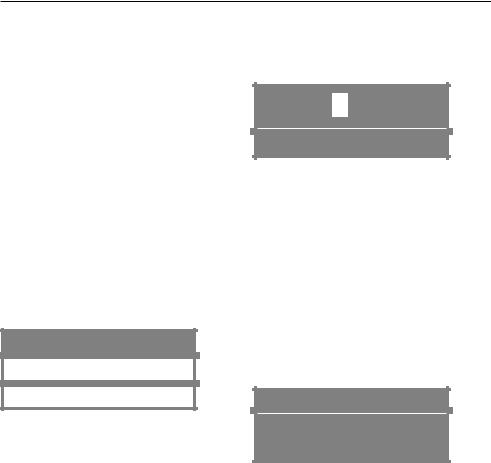
Before using for the first time
When the tumble dryer is switched on for the first time, the welcome screen will appear.
The welcome screen will appear in the display every time you switch the machine on until you have run a programme lasting longer than 1 hour.
The display for setting the language will then appear.
Setting the language
You need to select the language you require for the display.
You can select a different language from the one shown.
It is possible to change the language at any time via the Settings menu.
Language
english
) |
OK |
|
|
^Select the language you require by
pressing the left hand Menu button under ~.
^Confirm your selection by pressing the right hand Menu button under
OK.
The display for setting the time will then appear.
Setting the time (of day)
12:00
Change |
OK |
^Select the hours you want by pressing the left hand Menu button under Change, and confirm this with the right hand Menu button under
OK.
^Then set and confirm the minutes. The entry menu will appear.
Entry menu
The entry menu showing the current time of day will appear after the machine has been switched on, until you select a programme.
10 : 00
Select programme
^You can now load the laundry into the dryer and select a programme as described in "How to dry correctly".
13

Notes on laundry care
Care symbols
Before drying check the drying symbol on the care label. If there are no symbols, dry at your own risk!
q . . . . . . . . . Dry at normal temperature r . . . . . . . . . . . . Dry at low temperature s . . . . . . . . . . . . . . . Do not tumble dry
Tips on drying
–Always observe the maximum recommended loads given in the "Programme chart". Never overload the drum.
Overloading can cause unnecessary wear and tear to the laundry, give a disappointing drying result and cause more creasing.
–Do not put soaking wet items into the tumble dryer. Spin them thoroughly after washing using the appropriate spin speed.
–For delicates and fabrics with the following care label r select Low temperature.
–Use the Automatic programme for drying mixed loads of cottons and minimum iron fabrics.
–Open jackets so that they can dry evenly.
–Woollens and wool blends tend to become matted and shrink if dried in a tumble dryer. They can, however, be partially dried using the Woollens handcare programme.
–Down-filled garments have linings which have a tendency to shrink, depending on the quality of the item. They can be partially dried using the Smoothing programme.
–Pure linen should only be machine dried if specified as suitable by the manufacturer on the care label, as the surface of the fabric may otherwise become rough. They can be partially dried using the Smoothing programme.
–Loopknit garments (e.g. T-shirts and underwear) tend to shrink depending on their quality. Do not over-dry these textiles. Be particularly careful when using the Hygiene programmes. When purchasing these garments it is advisable to take their shrinkage properties into account.
–For garments made from very fine weave fibres, such as shirts or blouses, use the Shirts programme to avoid creasing. If in doubt, reduce the load or use the Smoothing programme.
–Starched laundry can be dried in the tumble dryer. To achieve the usual finish, double the amount of starch should be used.
–New dark coloured garments should be washed and dried separately from light coloured garments to avoid the danger of colours running and discolouring other garments or even plastic components in the machine. Dark coloured fibres can also settle on light coloured garments and vice versa.
14
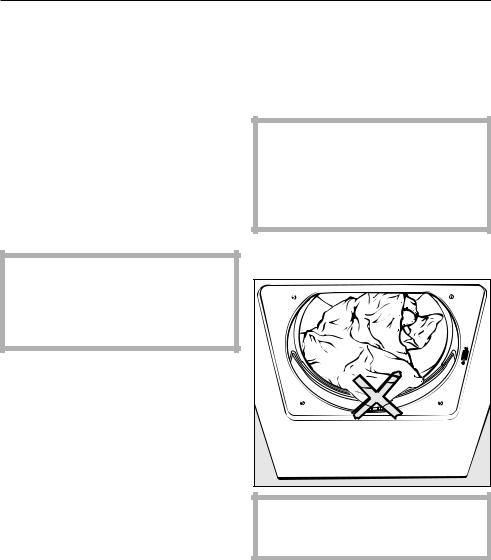
How to dry correctly
Brief instructions
The headings numbered (A, B, C ...) show the operating sequence and can be used as a brief guide to using your dryer.
A Sort the laundry
To ensure an even drying result separate out the washed laundry and sort it according to:
. . . the drying level required
. . . the type of fibre or weave
. . . size
. . . the moisture content after spinning.
,Make sure that objects e.g. detergent dispensing balls have been removed from the laundry. They could melt, and cause damage to the dryer or the laundry.
–Check seams and stitching to ensure that padding and linings are intact.
–Fasten duvet covers and pillow cases to prevent small items from being trapped inside them.
–Fasten hooks and eyes etc.
–Tie fabric belts and apron strings.
–Sew in or remove underwiring from bras.
B Turn on the tumble dryer
^Switch the dryer on by pressing the
I-On/0-Off button in.
The tumble dryer may be switched on after loading, saving energy as the light will not come on.
C Load the tumble dryer
^Press the Door button to open the door.
^Load the laundry loosely into the drum.
Do not overload the drum. See the "Programme chart" for recommended loads for each programme. Overloading can cause unnecessary wear and tear to the laundry and give a disappointing drying result.
^Before closing the door make sure the fluff filter is correctly positioned.
Check the laundry is right inside the drum so that it cannot get trapped or damaged when the door is shut.
^Shut the door either with a gentle swing, or lean against it and push it shut.
15
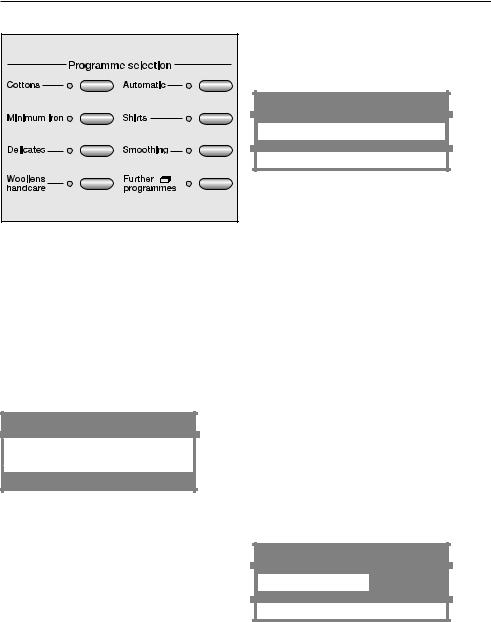
How to dry correctly
D Select a programme
^Press the button for the programme you wish to select.
The indicator light for the programme selected will light up and the programme name will appear in the display.
Programmes with drying levels:
Cottons, Minimum iron, Delicates, Automatic, Shirts, Denim, Sportswear and Outerwear
Cottons
|
Duration: |
1:52 h |
|
|
|
|
|
|
|
|
|
|
^ ^ ^ ^ ^ ^ |
Extra dry |
|
^Press the left or right hand Menu button reapeatedly until the drying level you want appears in the display.
–Any of the drying levels can be selected for the Cottons programme. A more limited range is available when using other programmes.
Important: Please note that the programme duration shown in the display will vary according to the programme selected (see "Programme duration / Estimated time remaining").
You cannot alter the drying level of the
Woollens handcare and Smoothing programmes.
Further programmes
Further programmes
Denim
Continue |
OK |
|
|
^Press the left hand Menu button under Continue repeatedly until the programme you want appears.
^Confirm your selection of the programme by pressing the right hand Menu button under OK.
–You can select the drying level for the
Denim, Sportswear and Outerwear programmes, as described in "Select a drying level".
–You cannot alter the drying level of the Pillows, Silks handcare, Proofing, Cottons hygiene and Minimum iron hygiene programmes.
–You can select a programme duration of . . .
. . . 15 minutes to 2 hours for the
Warm / Cool air timed drying programmes
. . . 1 to 2 hours for the Timed drying hygiene programmes
Warm air
Duration: 0:15 h
Decrease |
Increase |
|
|
^Press the Menu buttons under
Increase or Decrease to lengthen or shorten the duration of the timed drying programmes.
16
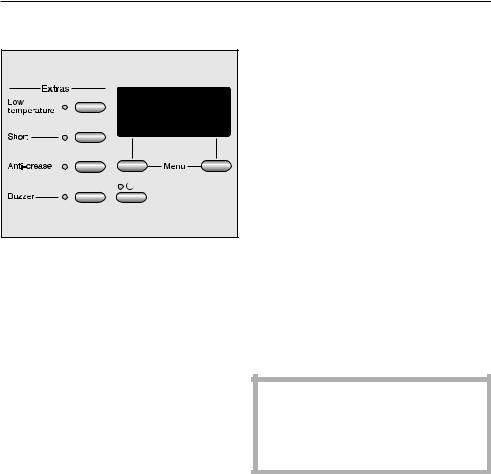
How to dry correctly
E Select any Extra options / Delay start
^Select any extra options or delay start by pressing the appropriate button (see "Extra options" and "Delay start" for more details).
F Start the programme
The indicator light for the Start/Stop button will flash when a programme is being selected. The flashing indicates that a programme can be started.
^ Press the Start/Stop button.
The indicator light for the Start/Stop button will now light up constantly.
Drying will appear in the display and the time remaining will start counting down.
With programmes with drying levels, e.g. Machine iron, Hand iron etc. the drying level reached will be shown in the display later on.
Before the end of a programme
There is a cooling down phase at the end of the drying sequence: Cooling down will appear in the display. The programme will not finish until the cooling down phase has been completed.
There is no cooling down phase at the end of the Woollens handcare, Silks handcare and Smoothing programmes.
G Remove the laundry when the programme has finished
Anti-crease (if selected) and Finished will appear in the display to indicate that the programme has finished. The buzzer (if selected) will sound at intervals.
^Press the Door button to open the drum door.
^Remove the laundry.
Check that all items have been removed from the drum. If items are left in the dryer, they could be damaged by overdrying when the dryer is next used.
If the dryer is switched on at the mains and the door is opened, the drum lighting will come on. It will go out a few minutes later to save energy.
^Switch the dryer off by pressing the l-On/0-Off button.
^Clean the fluff filters.
^Close the door.
^Empty the condensed water container (unless the dryer has been connected for external drainage).
17

Extra options
–It is not possible to select the Short and Low temperature options at the same time.
–Not all the extra options are suitable for use with every programme.
Low temperature
For drying delicates and fabrics with the r symbol on the care label at a lower temperature.
–For all delicate or minimum iron fabrics with the r symbol on the care label (e.g. acrylic garments).
–The programme duration is longer.
–On some programmes Low temperature is a standard part of the programme and so cannot be deselected.
Short
For drying fabrics which can withstand higher temperatures and have q on the care label. Do not use on minimum iron or delicate fabrics.
– Fabrics are dried more quickly.
Anti-crease
Helps prevent creasing, if laundry is not normally removed immediately after the end of a programme.
–The drum will turn at intervals for an hour after the programme has finished.
Buzzer
A buzzer sounds (at intervals for a maximum of 1 hr) to let you know the programme has finished.
–The buzzer can be selected for all the programmes and at any time.
–You can change the volume of the buzzer. See "Settings menu J".
–The buzzer will always sound when there is a fault, even if it has been switched off.
18
